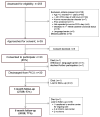Functional recovery following critical illness in children: the "wee-cover" pilot study
- PMID: 25651047
- PMCID: PMC4499478
- DOI: 10.1097/PCC.0000000000000362
Functional recovery following critical illness in children: the "wee-cover" pilot study
Abstract
Objective: To determine the feasibility of conducting a longitudinal prospective study to evaluate functional recovery and predictors of impaired functional recovery in critically ill children.
Design: Prospective pilot study.
Setting: Single-center PICU at McMaster Children's Hospital, Hamilton, Canada.
Patients: Children aged 12 months to 17 years, with at least one organ dysfunction, limited mobility or bed rest during the first 48 hours of PICU admission, and a minimum 48-hour PICU length of stay, were eligible. Patients transferred from a neonatal ICU prior to ever being discharged home, already mobilizing well or at baseline functional status at time of screening, with an English language barrier, and prior enrollment into this study, were excluded.
Interventions: None.
Measurements and main results: The primary outcome was feasibility, as defined by the ability to screen, enroll eligible patients, and execute the study procedures and measurements on participants. Secondary outcomes included functional status at baseline, 3 and 6 months, PICU morbidity, and mortality. Functional status was measured using the Pediatric Evaluation of Disability Inventory and the Participation and Environment Measure for Children and Youth. Thirty-three patients were enrolled between October 2012 and April 2013. Consent rate was 85%, and follow-up rates were 93% at 3 months and 71% at 6 months. We were able to execute the study procedures and measurements, demonstrating feasibility of conducting a future longitudinal study. Functional status deteriorated following critical illness. Recovery appears to be influenced by baseline health or functional status and severity of illness.
Conclusion: Longitudinal research is needed to understand how children recover after a critical illness. Our results suggest factors that may influence the recovery trajectory and were used to inform the methodology, outcomes of interest, and appropriate sample size of a larger multicenter study evaluating functional recovery in this population.
Conflict of interest statement
The remaining authors have disclosed that they do not have any potential conflicts of interest.
Figures



Comment in
-
Functional status after pediatric critical care: is it the disease, the cure, or both?Pediatr Crit Care Med. 2015 May;16(4):377-8. doi: 10.1097/PCC.0000000000000380. Pediatr Crit Care Med. 2015. PMID: 25946262 Free PMC article. No abstract available.
References
-
- Lawn JE, Kinney MV, Black RE, et al. Newborn survival: a multi-country analysis of a decade of change. Health policy and planning. 2012;27(Suppl 3):iii6–28. - PubMed
-
- Hartman M, Lin JC. Functional outcomes for children with severe sepsis: is a “good save” good enough?*. Pediatr Crit Care Med. 2013;14(9):893–4. - PubMed
-
- Namachivayam P, Shann F, Shekerdemian L, et al. Three decades of pediatric intensive care: Who was admitted, what happened in intensive care, and what happened afterward. Pediatr Crit Care Med. 2010;11(5):549–55. - PubMed
Publication types
MeSH terms
Grants and funding
LinkOut - more resources
Full Text Sources
Miscellaneous

